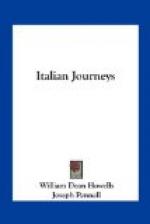They were rather troublous times, and not to be recalled here in all their circumstance; but I think it due to Vicenza, which is now little spoken of, even in Italy, and is scarcely known in America, where her straw-braid is bought for that of Leghorn, to remind the reader that the city was for a long time a republic of very independent and warlike stomach. Before she arrived at that state, however, she had undergone a great variety of fortunes. The Gauls founded the city (as I learn from “The Chronicles of Vicenza,” by Battista Pagliarino, published at Vicenza in 1563) when Gideon was Judge in Israel, and were driven out by the Romans some centuries later. As a matter of course, Vicenza was sacked by Attila and conquered by Alboin; after which she was ruled by some lords of her own, until she was made an imperial city by Henry I. Then she had a government more or less republican in form till Frederick Barbarossa burnt her, and “wrapped her in ashes,” and gave her to his vicar Ecelino da Romano, who “held her in cruel tyranny” from 1236 to 1259. The Paduans next ruled her forty years, and the Veronese seventy-seven, and the Milanese seventeen years; then she reposed in the arms of the Venetian Republic till these fell weak and helpless from all the Venetian possessions at the threat of Napoleon. Vicenza belonged again to Venice during the brief Republic of 1848, but the most memorable battle of that heroic but unhappy epoch gave her back to Austria. Now at last, and for the first time, she is Italian. Vicenza is
“Of kindred that have greatly expiated
And greatly wept,”




